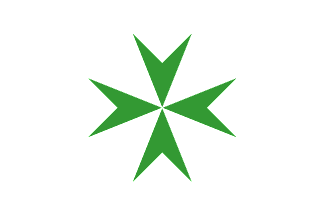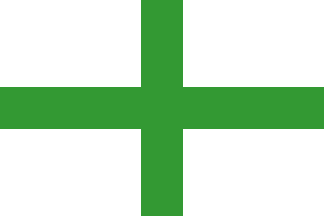 by Klaus-Peter Pokolm
by Klaus-Peter Pokolm
Last modified: 2006-03-11 by martin karner
Keywords: christian orders | order of saint lazarus of jerusalem | saint lazarus of jerusalem | lazarus | catholic | christian |
Links: FOTW homepage |
search |
disclaimer and copyright |
write us |
mirrors
See also:
 by Klaus-Peter Pokolm
by Klaus-Peter Pokolm
According to Gautier de Sibert's History of the Military and Hospitaller
Order of Saint Lazarus of Jerusalem (pub. Paris, France. 1772), the Order was
first established during the time of Saint Basil, by the beginning of the 5th
century A.D., with the founding of its first hospital in the city of Ptolemais
(Acre). It is known that by the end of the first millennia A.D., the Order had
active hospitals in Acre, Jerusalem, Bethlehem and Nazareth. Today, this
Christian order has 7,000 members active in more than thirty countries across
five continents, and retains its commitment to charity and hospitaller
activities with its active clinics in Europe, Palestine, Africa, and the
Americas. The Order's government maintains its administrative seat at the Castle
Lanzun, on Malta; and, can be contacted through its website at:
www.st-lazarus.net.
The Order's flag is a green cross quartering a white flag.
Flags of the Order's jurisdictions feature an argent shield, quartered with a
cross vert, with a national symbol placed in the chief sinister quarter. Some of
these jurisdictional symbols are the thistle (Grand Priory of Scotland), crown
(Grand Priory of Hungary), flag of Austria (Priory of Austria) and the flag of
Denmark (Grand Bailiwick of Denmark), three crowns (Grand Bailiwick of Sweden),
three fleurs d'lys (Grand Priory of France), and eagle (America). The volunteer
corps of the Order utilizes a white flag with green Maltese cross centered.
Medals and Jewelry of the Order utilize the traditional eight-point Maltese
cross design, with an image centered, and contained within a circle, of Christ standing (on the right) with hand outstretched over the image of a
kneeling St. Lazarus (on the left). Encircling this image is the Order's motto: "Atavis
et Armis." (by Ancestors and Arms). In older medals struck before the
French Monarchy's restoration (1815-1830), the image is actually reversed, with
Christ on the left and St. Lazarus on the right. Thus, the "modern" usage of
Christ on the right side of the image was a change that occurred in the Order's
decorations during the early 19th Century.
The Order's use of the color green spans the past millennia. Some attribute its
use to the Order's survival through Moslem occupation of the Levant: use of the
color green would have been a safe practice under Moslem rule. Other legends
have it that green honors the memory of the Moslem General Saladin, who spared
Members of the Order after his capture of Jerusalem, and permitted its
hospitaller activities to continue. Another legend surrounds King Baldwin IV's
founding of the Lazarus Hospital and Commandery at Seedorf, in Switzerland,
after his vision which included finding a green cross in his hand upon waking
(this story predates Saladin, as does the next). Another legend surrounding King
Baldwin IV is that during his coronation in Jerusalem, an eagle dropped onto his
head a gold ring with sinople (green) cross embedded. What is certain is that
the green cross and color green have been traditionally associated with the
Order of Saint Lazarus, and this has been so at least throughout the second
millennia A.D.
According to the book Heraldry and the Grand Priory of America, by the Chevalier
Dr. Felix W. G. v.L. Holewinski, KCLJ, Grand Priorial Archivist and Herald of
Arms (published by the Grand Priory of America, 1997): "...A green cross on a
silver field (argent, a cross vert) was adopted by the first Knights of the
Order which besides appearing on their banner was worn on their surcoats and
shields. This simple green "Greek" cross was altered to the eight-pointed
"Maltese" cross by Grand Master Jean de Livis (1557 - 1564). The original
armorial bearing of the Order when displayed in "full achievement" used a green
Latin cross - usually with its three upper arms somewhat extended, similar to a
"cross paty" - issuing out of a green-silver wreath placed on a helmet with
green mantling, doubled silver. A sixteenth century armorial great achievement
of the Order displayed a much more elaborate design. This armorial bearing
included a simple rosary which encircled the shield like a collar, emphasizing
the religious nature of the Order. ...The ancient motto of the Order En Guerre
et en Paix (In War and
Peace) was changed in the 18th century to the current motto Atavis et Armis (by
Ancestors and Arms)."
William J. Cox, CLJ, 19 February 2003
Assistant to the Vice Chancellor for Administration
Grand Priory of America of the Order of St. Lazarus
Lazarus Volunteer-Organisations like the "Lazarus-Hilfswerk" use the eight
pointed green cross on a white flag.
Klaus-Peter Pokolm, 15 June 2003
The Order also uses the coat of arms on the flag of the Grandmaster of the
Order and another with the motto of the Order.
Klaus-Peter Pokolm, 15 June 2003
From <www.st-lazarus.net>:
The Constitution
Chapter 1 - The Constitution
1.6 BANNER AND ARMS OF THE ORDER
a The Banner of the Order is: Argent a
Cross vert.
b. The Arms of the Order are: Argent a Cross
vert, surmounting a Cross of eight Beatitudes, encircled by The
Grand Collar, the whole on a mantle sable, with tarsils and
ornaments or, on the sinister side bearing the Cross of eight
Beatitudes vert, over all the Eastern Crown of the Order lined
sable on which is borne a Cross and Orb or; beneath the arms is
the motto "Atavis et Armis".
c. The arms of the Order, with or without the
motto, may be used by the Order itself and by its Jurisdictions
only, but not by individual Members.
d. Differenced Banners and Ensigns as well as
Pinsil and Standard of the Order as prescribed in the General
Regulations (Part 3, chapter 9, section 1) may be used by various
Jurisdictions, Volunteer Corps and Senior Officers.
1.7 BANNER, ENSIGN AND ARMS OF THE GRAND MASTER
a. The Banner and the Ensign of the
Grand Master are:
Argent the full personal arms of the Grand Master, golden
fringed.
b. The Arms of the Grand Master are:
Quarterly, 1 and 4, the arms of the Order; 2 and 3, the personal
arms of the Grand Master.
From <www.st-lazarus.net>
:
General Regulations
Chapter 9 - Other Banners, Ensigns and Seals
9.1 OTHER BANNERS, ENSIGNS, PINSIL AND STANDARD OF THE ORDER
a. The Banners of Jurisdictions are: The
banner of the Order, differenced with an appropriate device in
the dexter chief canton. Such devices must be approved by the
Judge of Arms of the Order.
b. The Ensigns of the Order are: Argent the
full arms of the Order, golden fringed for members of the Supreme
Council, silver fringed for Heads of national Jurisdictions,
unfringed for all other officers of the Order.
c. The Pinsil of the Order is: Argent with
the arms of the Order in the center.

d. The Standard of the Order is: in the
hoist, argent a cross vert: in the fly, argent semee of crosses
of eight beatitudes vert, two bands azure bearing the motto
"Atavis et Armis".
e. All Banners and Ensigns used within the Order
must be registered at the office of the Judge of Arms of the
Order.
13.7 BANNER
The Banner of the Volunteer Corps is: Argent an eight-pointed cross Vert.
Dov Gutterman, 23 January 2002